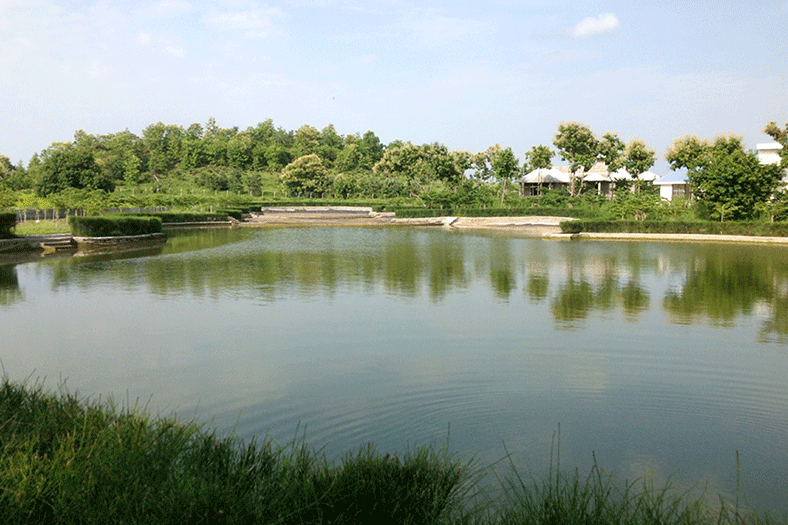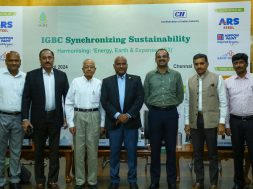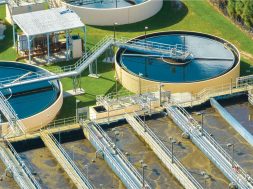Landscape Design: The Essentials

The basic expectation from landscape designing is to beautify the building surroundings or leftover open spaces to create green visual effects says renowned landscape architect Kalpak Bhave.
Among other things one of the major aspects of landscape design is water, a good landscape can’t be created without enough water availability except in few cases of hard landscape. Water is the heart of any good green landscape.
Visual use of water in landscape
Other than the need for water for plants, water bodies and other water features are created to enhance the landscape as water is the only live element in the landscape. Presence of water in the landscape attracts the user. The water in the landscape can be presented in various formats such as waterfall, stream, fountain, swimming pool, kid’s pool, jacuzzi , lake or pond etc.
These are common and usual usage of water which is mainly visual. Water also can be handheld for functional usage. The water in the landscape has much more potential than all of the above factors in real terms, which will remain unexplored if the landscape architect doesn’t go the extra mile.
A proper landscape planning can be a solution to various problems on site. This needs detailed discussions with the client to understand the problem well and then working over the same to resolve the problem by in depth study and visual and functional landscape proposal.
Functional use of water in landscape
Water has diversified roles to play in landscape. India has varied climatic zones, different kinds of soils, ground terrain and hence the water needs in all areas are different. Water on any site can be well managed looking at the needs of the site.
We need to consider the climate of the area, depth of ground water table, its history, overall rainfall and rain pattern of the area, landscape requirements, site contours, water needs for designed activities etc. These are the various factors to be considered while designing functional water management for the site.
On some sites we need to handle the additional water by various landscape design solutions or in some cases you need to store the water for better percolation to raise the ground water table. In some cases, due to the high water table you need to handle water differently.
We were working for a project in Dibrugarh in Assam for Unilever Limited, where we had a very shallow water table. We excavated a few feet and got water. The approach for landscape designing with water was different on this site and we made use of a high-water table to create streams with boulders in landscape. We planted trees which had high water needs to sustain so additional water can be absorbed well.
On another site in Silvassa for Treat Resort, we reclaimed the entire large water body into the party lawn due to unavailability of required water to fill the water body. There are two more examples of functional water management at two different locations in India.
Sivana farms – Nagpur
We had been awarded a project of Sivana farms, which was located 50 km from Nagpur working as a consulting and landscape architect. We were responsible for designing the entire project spread over around 70+ acres. We studied the water table of the area and found that it’s very low. The mountains around us had good rainfall but the entire run off was leading to the river and no water percolation was happening. There was hardly any percolation to recharge the underground water table. We suggested first to have a large water collection pond which allows us to percolate water and not to drain out the same to the river close by. We had two water streams from the mountains joining at place and moving further as Nalla .We tapped this place and created a large water body with good depth which resulted in holding around five crore liters of water in it. Any further water will be allowed to overflow.
We did not carry out any lining for the bottom of this water body as we needed maximum water to percolate. We followed this process for three years and witnessed how the drying up of the water body gets delayed each year. This delay resulted in having water throughout the year in the artificial lake.
This large water body would offer a huge percolating area to water which helps in increasing the groundwater .This huge amount of water otherwise would have flown down to the river and then to sea.
This club house project utilises the backdrop of a large lake to good effect. Party lawns , an open air theatre were designed between the club and lake. This visual feature of the created lake offers opportunities to percolate water and help in increasing the ground water table of the area.
Welspun India – Anjar – Kutch
We had been appointed to design the landscape for Welspun India -Anjar – Kutch where the entire township of Welspun spreads over hundreds of acres.
This was done with terry towel manufacturing and MS Pipe manufacturing unit with 100 per cent exports to US and UK from Kandla Port. This unit creates a discharged water of almost one crore liter per day. This is created majorly with dying and repetitive washing of terry towels. The water goes under various treatments except decolouring and thus creates muddy coloured water of huge quantity.
At first level the water is consumed by planting thousands of trees. The tree varieties have been shortlisted which needs more water. We selected the varieties line millingtoniahortensis, eucalyptus varieties, delonixregia etc. to consume maximum possible water and still we were left with lots of water. Then we need to do a detailed study and find other ways to get rid of water.
The site has heavy clay in soil hence water does not absorb any water, so percolation of water has been ruled out. Being treated water, it cannot be discharged outside the plot into natural water streams or any Naala.
At the second level we created evaporation ponds by just excavating in ground up to almost a meter and filling it up with treated water. The muddy red water filled in such a pond appears blue owing to the reflection of the sky. As the sun is harsh throughout the year, it increases the rate of evaporation.
We created five such ponds with each having an area of around eight acres. Each pond offers 40 acres of surface area for evaporation. This worked well since the sun rays are harsh almost throughout the year. The average rainfall of the area is 2”, which also may not happen every year. This resulted in developing an ecosystem as lots of birds started coming here for water. Plantations around also helped in developing the ecosystems.
Cookie Consent
We use cookies to personalize your experience. By continuing to visit this website you agree to our Terms & Conditions, Privacy Policy and Cookie Policy.









